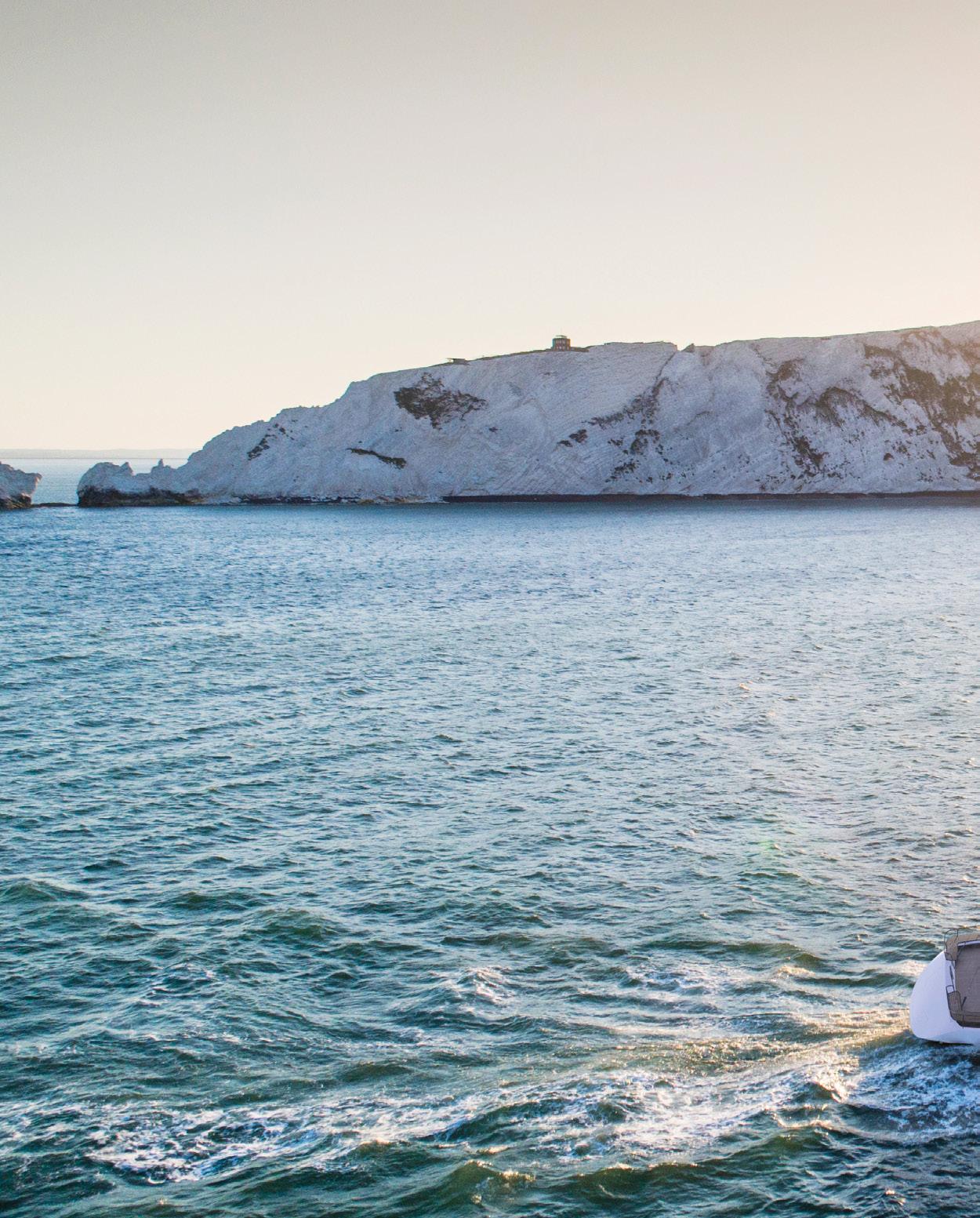
27 minute read
DESTINATION MAINE
FLAGSTAF LAKE
MOOSELOOKMEGUNTIC LAKE
FARMINGTON BINGHAM
SKOWHEGAN
SOUTH PARIS
SEBAGO LAKE
AUBURN LEWISTON
BRUNSWICK AUGUSTA
WISCASSET
BATH
WESTBROOK
PORTLAND
DOVERFOXCROFT
NEWPORT
BELFAST
CAMDEN
ROCKLAND
WEST GRAND LAKE
BIG LAKE
CALAIS
BANGOR
GRAHAM LAKE
ELLSWORTH HARRINGTON MACHIAS
MOUNT DESERT ISLAND
From immaculate beaches to its impressive mountain backdrop, Maine is an area renowned for its wild, natural beauty. Yet there is one simple fact that stands out head and shoulders above the rest, Maine is big, really big.
With a coastline just shy of 3,500 miles, it is the fourth longest in the States, bigger than those of Texas and California. Yet, the irony of such an expansive cruising ground is that once you are there, exploring this special region doesn’t mean that long days covering big distances are required. Instead, Maine can be enjoyed in bite-sized chunks and cruised at your leisure.
So, while we have set out a suggested programme that will help you do just that, the following guide is less of an itinerary and more of an indication as to how to enjoy two weeks of leisurely cruising based on around half a day’s sailing at a time.
Furthermore, with this in mind and with so much to choose from, those that do want to stretch their legs a little more it is easy to extend your visit without turning the trip into a race against the clock. Aside from its wildlife with seals, dolphins, whales and a wide variety of birds, Maine is also well known for its seafood restaurants ranging from local lobster shacks to five-star venues. And if this appeals, you should definitely plan to schedule in some time ashore.
The bottom line is that Maine is a special place and while getting there takes a little longer and will often require patience with weather that doesn’t always play ball thanks to its famous fog, as those that have become hooked will attest, this is a very special destination and well worth the effort.
RIGHT:
LYMAN MORSE AT WAYFARER MARINA IS THE PERFECT PLACE FOR PROVISIONS BEFORE BEGINNING THE TRIP.
THE OUTLINE PLAN
For all these reasons and plenty more, the key tip is that Maine takes time. With such a large area to explore and with so much to see, accepting that two weeks only scratches the surface will help to set the right pace.
Getting the boat to the area is a mini project in itself. The 157nm trip from the Cape Cod Canal to Camden will take around 24 hours (30 hours from Newport). This can be broken down into two legs if you prefer by making the first stop after 100nm in Portland.
This city is popular with some who are joining their boats as it is close to the airport, there is a large marina and plenty of shopping and eating along with good music and nightlife. In the summer, there is a great fish market and plenty of farmers’ markets too.

IDEAS TO BUILD A 14 DAY TRIP
9
CASTINE
START POINT – CAMDEN
Camden in Maine is the hub for cruising in Penobscot Bay. The sailing here offers reasonable stretches in deep open water and is similar to the Scottish Hebrides.
Camden a classic Maine town. Although it is busy with tourists in summer it is still authentic Maine. It is important to reserve dockage/moorings in advance because they sell out and the anchorage isn’t great. Lyman Morse at Wayfarer Marina is a great marina and bar and is a short walk or dinghy across into town. As you would expect from such a hub, there is lots of shopping with several must visits that include:
Bookstore/café: Owl and Turtle; Thai food/market; Long Grain - Asian restaurant; Natalie’s at Camden Harbour Inn.
10
CAMDEN
DAY 14
1
After a relaxing morning depart for your journey home.
DAY 1 - CAMDEN TO PULPIT HARBOR
Leave Camden to sail across Penobscot Bay and anchor in Pulpit Harbor, one of the most peaceful and protected anchorages in Maine, a quiet cove with ospreys.
DAY 10 - ISLESBORO TO ISLE AU HAUT
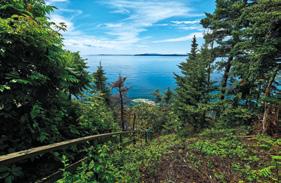
Anchor in Duck Brook and hike up to Duck Mountain for a view from the highest island in Penobscot Bay.
DAY 9 - CASTINE TO ISLEBORO
Gilkey Harbor is a secure anchorage with good holding ground, and is frequented by many yachts in summer. There are a number of private float landings for small craft, but no commercial wharves. Dark Harbor has grocery and hardware stores, a snack bar, and a gas station. Craft visiting the resort tie up at the yacht club or other private floats in Gilkey Harbor.
13
ROCKPORT
DAY 13 - ROCKPORT TO CAMDEN
From here it’s a beautiful and straightforward sail along the coast back to Camden Harbor.
DAY 12 - VINALHAVEN TO ROCKPORT
Crossing the open stretches of the West Penobscot Bay, sail from Vinalhaven to Rockport. Here, one of the key places to visit is the Farnsworth museum which offers a nationally recognised collection of works from many of America’s greatest artists such as Andrew Wyeth.
2
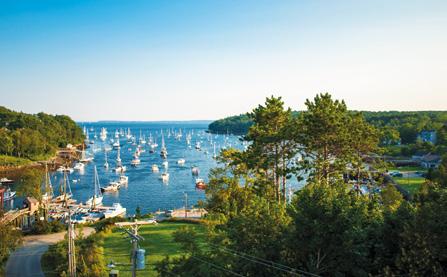
PULPIT HARBOR
3
NORTH HAVEN DAY 2 - PULPIT HARBOR TO NORTH HAVEN
From Pulpit Harbor, head down to the southwest before turning northeast to head towards Fox Island Thoroughfare and North Haven.
DAY 3 - NORTH HAVEN TO MCGLATHERY ISLAND
In the morning, continue east through Fox Island Thorofare to Merchant’s Row, just south of Deer Isle. There are many islands here with beautiful small coves in which to anchor for the evening. McGlathery Island is a must where you can anchor at the eastern end. This is a protected uninhabited island which has a nice sandy beach and a path that goes around the island. This is a favourite island for those in the know.
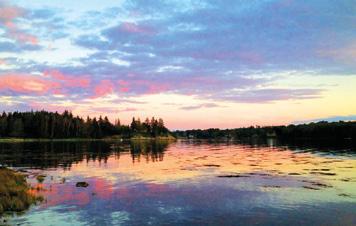
12
VINALHAVEN

8
CENTER HARBOR
DAY 8 - CENTER HARBOR TO CASTINE
Castine is a small Maine town on the mainland. There are a few quaint stores and a decent market. This is where the Maine Maritime Academy is based, sometimes the huge research ship is on the dock. Denett’s Wharf is a nice place to eat. The tide can rip in this harbour so docking can be tricky. You may want to get a mooring for a few hours and then tuck into Smith Cove for the night.
DAY 7 - SWANS ISLAND TO CENTER HARBOR
Heading northwest takes you through the Eggemoggin Reach to Center Harbor. This is an amazing sail with the right wind and clear sky. The town of Brooklin offers a General Store, the cosy Morning Moon café and possibly the most charming public library on the planet. There are plenty of craft shops and galleries which are all an easy stroll from here down to the Reach.
Take in some local flavour at the Brooklin Inn where in the basement you can chat with some of the local characters from the Wooden Boat School. The Brooklin Boatyard is a great place to check out the local marina life, opened in 1960 by Joel White and presently operated by his son Steve. They have the best craftsmen in the state and visitors are welcome. Ask for Steve, Frank or John to give you a tour. For dinner, have a lobster bake at the Wooden Boat School Building.
MCGLATHERY ISLAND
4 7
SWANS ISLAND DAY 5 - SOUTHWEST HARBOR TO NORTHEAST HARBOR

Staying in this area, head to Northeast Harbor and visit the beautiful Cranberry Island along the way.
NORTHEAST HARBOR
SOUTHWEST HARBOR 5 6
DAY 6 - NORTHEAST HARBOR TO SWANS ISLAND
Heading back towards the south west, Swans Island feels remote and has the true flavour of the Penobscot. This island makes its living fishing for lobster and is virtually untouched by tourism. There is a totally protected harbour and rental moorings. You can sleep well and secure here. Good lobster is available and this is a great place to explore the town on foot, or with dinghy. A lovely Maine place.
ISLE AU HAUT
11
DAY 11 - ISLE AU HAUT TO VINALHAVEN.
Vinalhaven is Maine’s largest offshore island community. Carvers Harbor, on Vinalhaven’s southern end is home to one of the world’s largest lobster fishing fleets.
DAY 4 - MCGLATHERY ISLAND TO SOUTHWEST HARBOR
Head northeast for Mount Desert Island, the home of Acadia National Park. If you enjoy hiking there are miles of beautiful trails to explore. Another option is to sail into Somes Sound on the south side of the island. The only fijord on the east coast, Valley Cove is a great spot to anchor for lunch. Spend the night on a mooring in Southwest Harbor.

MUST READ
Penobscot Bay — A Cruising Guide to the Maine Coast
This guide provides well written stories with hand drawn charts and beautiful pictures of the area, providing plenty of ideas and reasons to visit some of the special local areas. Coverage of every harbour and anchorage are included, along with detailed suggestions for shoreside activities from hiking to dining.
IMPORTANT POINTS
In Maine you can’t navigate at night as there are too many lobster pots, even navigating during the day is tricky in certain places. Generally, it is best to get a mooring rather than anchor.
This cruise plan is based on notes from Molly Marston – Head of Oyster Charter, who lives in the area and has both cruised this region for many years and provided plans for those who are chartering in the area.
RIGHT:
PORTLAND HEAD LIGHTHOUSE, CAPE ELIZABETH, A FAMILIAR LANDMARK IF HEADING BACK TO NEWPORT RHODE ISLAND.
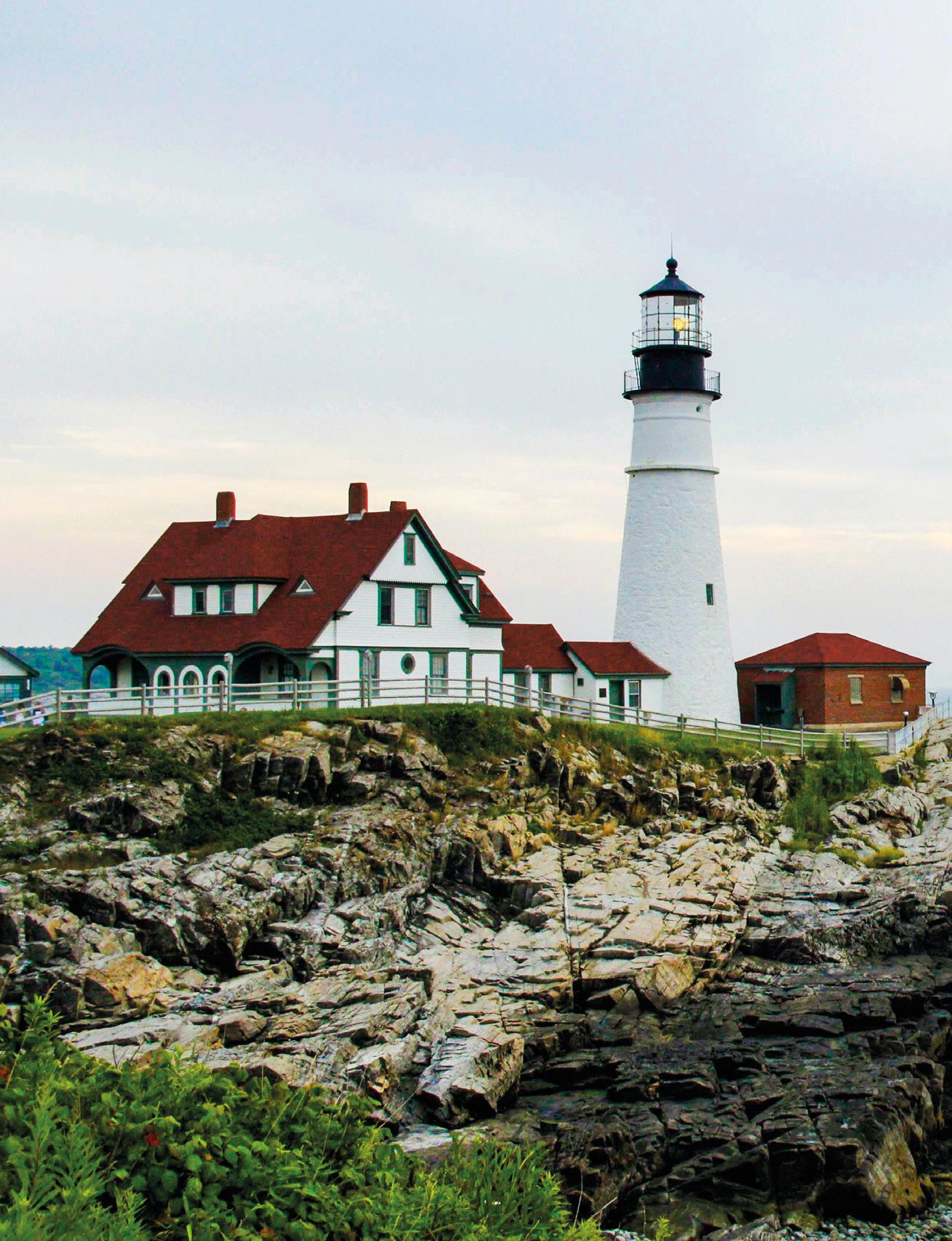
BEST TIME TO CRUISE
While Maine is a beautiful part of the world, those that know it well say the best time to visit is during the last three weeks in August. The water is warm and the weather is usually settled.
However, it’s important to remember that this is still an exposed coastline that has a reputation for fog and will generally be colder than further south.
Just as those who are familiar with the west coast of Scotland take each and every sunny day as a bonus, so the same can be true of Maine. As a result, so long as you’re armed with realistic expectations and ready to take the weather as it comes it will always be a stunning place to visit. So, while Maine may be big, it is easy to create a fascinating and easily managed cruise that can be adapted to suit the weather without having to face the consequences of a long passage to get back on schedule. We had an amazing summer in Maine on Dama de Noche, with all the family rotating in shifts. It truly is a magical coastline, like Cornwall on steroids! I really recommend it for the cruising experience of a lifetime, as long as you don't mind zig zagging through a million lobster pots. p.s. the lobsters themselves are worth visiting for alone!
ALAN PARKER
82 DAMA DE NOCHE

We take a look behind the scenes at our boat yards, discovering more about the people who bring our yachts to life and the time-honoured skills they bring to their jobs. We recently caught up with Matt Cook, Assistant Joinery Manager at Wroxham, to hear about the important role he and his team play in every yacht.
What does your role involve?
I organise and co-ordinate the joinery work on the 565, 595 and 675 models. Day to day, I work closely with boat builders, joiners, finishers and varnishers through to the Mill and CNC department to ensure the exacting standards and attention to detail. I’m involved in every part of the boat build and I have very high standards – some might say I’m a bit pedantic, but I like to think of it as thorough!
What’s your background?
I’m a joiner by trade. I started out restoring sash windows and working on listed building restoration, then I made the move into the marine sector in 2008 when I joined Oyster Yachts and I’ve never looked back. I’ve worked with my hands my whole life, but in recent years I’ve been able to adapt and use my knowledge and expertise to oversee and co-ordinate all the joinery work at Oyster Wroxham.

What attracted you to the business?
The reputation. Oyster Yachts are recognised as the best sailing yacht makers in the industry, so when the opportunity came up I didn’t hesitate! The role met with the reputation and the skill levels of the team and their pride in the workmanship was at a standard beyond my expectation. Oyster Yachts are built to last a lifetime, some are even passed down through generations of families. For me, the ultimate satisfaction of the role is the end result – seeing a stunning yacht, built to the very highest standards, leave the workshop. It’s very rewarding and instils a great sense of pride. For me, the ultimate satisfaction of the role is the end result – seeing a stunning yacht built to the very highest standards leave the workshop. It’s very rewarding and instills a great sense of pride.
MATT COOK
What do you enjoy most about your job?
Teamwork and collaboration. Bringing all the departments and owners together as part of a brilliant team to produce a very special product. I love solving all sorts of challenges to deliver unique finishes and options to meet owners’ requests.
What changes have you seen since you joined Oyster?
There have been lots of positive changes under Richard Hadida, to the yachts and the brand. In production there is an ongoing programme of value engineering and continual improvement in quality. I've seen the introduction of new build techniques on the Oyster 595. It lets us operate an even higher level of quality control and we’re always pushing to make things even better. The introduction of wiring looms has made a huge difference too. Now they are wired up on the joinery in the workshop, which is much easier and more efficient – so, when they go into the boat, it’s plug-and-play.
Richard Hadida’s vision for the company has seen a huge investment in software and streamlining the production process. We work hand-in-hand with the designers – we see them as craftsmen too, their computers are the equivalent of our hammers and chisels. In the end, it’s all based on the core values of the company, which comes down to quality and moving with the times.

What’s so special about working at Oyster?
The yachts of course! But it’s the people and fantastic teamwork that shines through in the excellent workmanship and the sense of pride we have when these yachts come together. It’s a key difference between us and our competitors. The brand under Richard Hadida has moved forward in ways I never thought of, it’s very unique and really special. Many of our craftspeople here are life-long boatbuilders, who are really passionate and proud to build Oysters. The old traditional trades and experience are passed down through generations, from one master to the next apprentice – as well as expertise, sometimes even their tools get passed down.
How does traditional boat-building marry with modern production techniques?
Any business needs to move with the times, whether you’re hand building boats or producing computers. Bringing in modern techniques to complement traditional skills adds value and enhances the overall quality of our yachts. What owners love about Oyster is the materials, quality and craftmanship. These yachts last a lifetime – I’ve heard that every Oyster ever built is still being sailed, which is pretty impressive. We embrace new ways of working, using machines and techniques to improve quality of the build and give the craftspeople more time to perfect those finishes only human hands can create.
MATT COOK
Does using the highest quality materials make your job easier or more rewarding?
It’s all about the best quality. Hardwoods like oak, teak and cherry are not so forgiving, so you have to be more accurate. Everyone has responsibility to make things as good as they can be and that’s where the team’s confidence, skills and experience really count. The Oyster standard is very, very high, but you’re always looking to push past it, to make things even better.
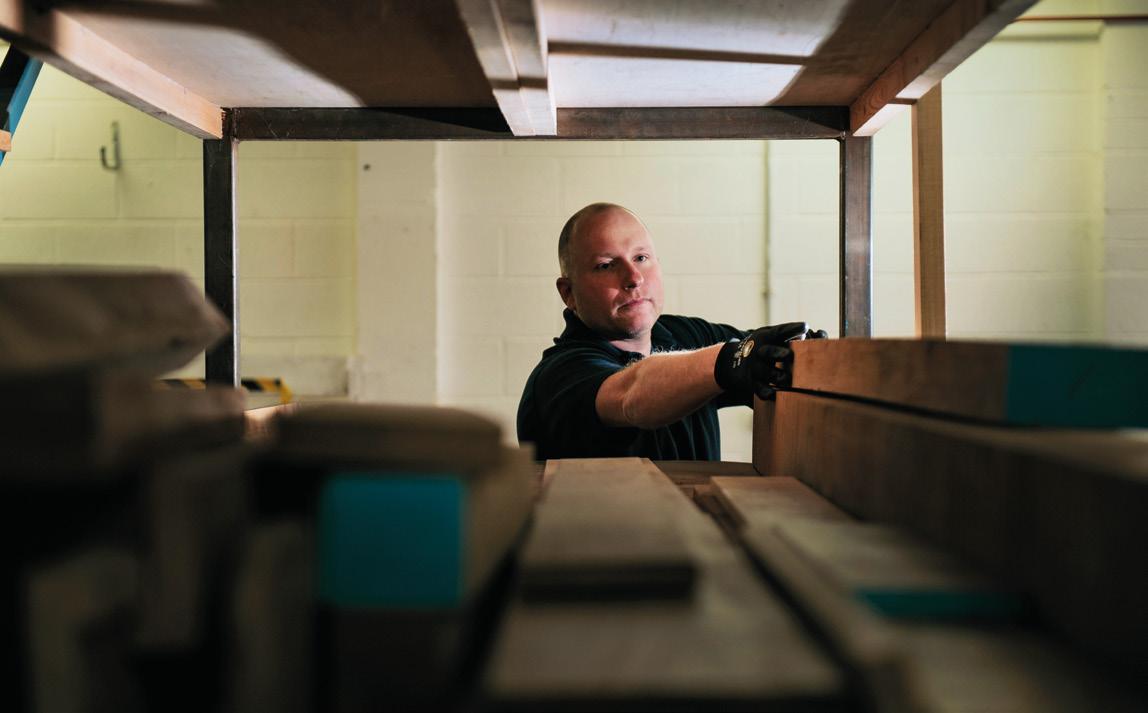
How do you feel when you see a finished Oyster leaving the yard?
We understand we are building a sailor’s dream yacht, in some cases a yacht they might have aspired to own all their lives. So it’s a very special feeling when we see the yachts leave the yard and get feedback from the commissioning team when they hand her over to an extremely happy and excited owner. We often get personal letters of thanks from owners too – they’ve invested a lot in us and trust in our workmanship. When you’re building someone’s dream, you take a lot of pride in the finish and it’s nice when that is acknowledged.
Why are owner visits so important?
It’s great to meet the people you’re building for. Hearing their plans for the boat, we get a sense of the sort of adventures she will go on and be used for. It helps give the team a sense of her identity and it makes each yacht more unique. Seeing the owners’ excitement and passion gives us a greater sense of pride in the job. Owners love seeing the high standards of craftsmanship going into their yacht, it creates a real connection. I always make a point of introducing the owners to the people working on their boat by name. Hopefully one day they will look at a piece of joinery when they’re somewhere far away and remember who built it. All of our yachts leave the yard with a build plaque which displays the signatures of the lead trades that built them. It gives us immense pride and can bring a tear or two to the owners’ eyes when they see it for the first time.
What’s so special about an Oyster?
It’s great being part of the family, it’s very supportive – I joined 13 years ago and I still love it. We are all focused on delivering the promise our yachts hold. The attention to detail that goes into each of them is really important, always looking at making things better. An Oyster comes with quality attached – our high standards in the build, the skills, workmanship and finishing. People aren’t just buying a yacht, they’re becoming part of something much bigger, it’s more than a yacht, it’s a passion. The yachts, they’re just special in themselves – an Oyster will take its owner on once in a lifetime adventures. And they’re built to last for a lifetime if they are cherished and cared for properly.
ABOVE:
SELECTING HARDWOOD TO BE HAND-CRAFTED INTO FURNITURE FOR THE INTERIOR OF A NEW OYSTER 595.
MATT COOK
Staying loyal to a brand is ultimately all about trust, which is why the Kjaernes family continues to uphold its long-term association with Oyster. Thirty five years since his father Nils bought an Oyster 46, Jorgen is now enjoying time with family and friends aboard his second new Oyster Chione II. Sue Pelling talks to Jorgen about his latest acquisition.
CHIONE II – OYSTER 675
JORGEN AND KINE KJAERNES
Jorgen Kjaernes confesses an addiction to the ocean which is why he is never without a yacht. He says his passion for sailing started at an early age and living in a house with a private jetty at the end of the garden, just south of Oslo, Norway, didn’t help his obsession either.
“I had my first boat at the age of eight; an Optimist and then a Flipper Scow, which I raced at the local sailing club. My early days on the water however, I remember vividly, sailing alone punching through the waves out towards the open ocean. Feeling totally connected to the sea and knowing that on the other side was first England and then America. I knew that one day, I would not turn at the lighthouse as I normally did, but would carry straight on!”
RIGHT:
LEAVING IBIZA, SAILING INTO THE NIGHT ON CHIONE II.

The Generation Game

I wanted a boat as large and comfortable as possible, and a boat that was built to cross oceans. She seemed to have everything including Oyster’s exceptional attention to detail finish. A trial sail proved that two people could easily operate her, which was exactly what my wife and I were looking for.

RIGHT:
JORGEN AT THE HELM OF HIS FATHERS OYSTER 46, JULIE IV, LEAVING IPSWICH ON THE PASSAGE TO MALLORCA. WELCOME COMPANY ON THE NIGHT PASSAGE TO NORTHERN SPAIN.
LIVING THE DREAM
Kjaernes’ obsession with sailing continued into his youth with offshore racing. His first real taste of Oysters, however, was when his father swapped his Hallberg Rassy 41 for a new Oyster 46 in 1986. That was where the fun started.
Kjaernes continued: “Three friends from school (Dan Skjelberg, Christen Agerup, and Osmund Skorge) joined me to take the boat directly from Southampton to Mallorca where she was to be moored. In 1986, 46ft was an enormous boat and the prospect of crossing the Bay of Biscay seemed a big challenge. We took exactly ten days to reach Gibraltar and two weeks to Mallorca (total of 1,628 nautical miles) in what we saw as the trip of our lifetime.”
The delivery trip with his father’s yacht was the start of new beginnings for Kjaernes because it paved the way for his own string of Scandinavian yachts including a Sweden Yacht and a Hallberg Rassy. “It was a great way of utilising the often beautiful, but very short Scandinavian summers,” said Kjaernes “but in 2012 I decided to move my base to Mallorca and I started looking for a ‘go everywhere’ yacht that I could keep in Palma. It wasn’t long before I made a decision to order my first Oyster, an Oyster 575, Chione I, which was delivered in 2014.”
After yet another fun delivery trip from Southampton to Palma with his trusted school friends, Kjaernes and his family enjoyed several years of extensive cruising on Chione I in the Mediterranean.
NEW HORIZONS

It was however, the announcement of the Oyster 675 in 2016 that marked the ‘end of the road’ for Chione I. Kjaernes continued: “I instantly fell completely in love with the 675 and I think it was a very good salesperson at Oyster who persuaded me [he says laughing].
“I wanted a boat as large and comfortable as possible, and a boat that was built to cross oceans. She seemed to have everything including Oyster’s exceptional attention to detail finish. Also, a trial sail proved that two people could easily operate her, which was exactly what my wife and I were looking for. “One of the attractions of sailing for my wife and I is that we can enjoy the privacy of being alone together, so we definitely did not want a boat that needed a permanent crew. Everything about the 675 was perfect for us so we placed an order and took delivery last year (2019).”


Commenting on the difference between the 575 and the 675, Kjaernes said: “The 575 was a truly lovely boat but naturally design evolves and significant improvements had trickled through to this newer model which provided enhanced living space and better performance.
The 675 is completely different; more modern, streamlined cockpit and deck layout and generally very sleek. It also has much better access to the water off the platform, which is something that really appealed to me for family cruising.”
The sale of Chione I in late 2017 and handing her over to new owners was an emotional time for the Kjaernes family but with a brand-new boat on order, it was an exciting time too. With plenty of previous yacht-owning experience, Kjaernes was keen to have a bit of input in the design layout including adding hatch access to the lazarette from the bathing platform.
“I had some ideas I wanted to incorporate such as a remodelled chart table area to include book shelves and detailed leather work, plus steps on the cockpit coaming. The lazarette hatch opening from the platform was something I was particularly keen on. I do believe though, that the Oyster 675 layout is quite perfect, so I actually didn’t alter much at all, just tweaked it a bit.”
THE VIKINGS RETURN
Chione II was launched on 28 April 2019 and preparations for her delivery trip to Palma began. One of the most exciting aspects of the trip was the fact that the same, original crew of school friends including Dan Skjelberg, Christen Agerup, Osmund Skorge, were keen to relive their last two Kjaernes family Oyster delivery trips. “I couldn’t have wished for a better crew,” said Kjaernes. “Although we’ve had plenty of family favourite days in the Mediterranean, cruising from Gibraltar Sardinia, Corsica, and the Balearics last summer, one of the most fun and memorable I can remember is the delivery trip to Palma, which began on 22 June 2019 from Southampton. The 675 is completely different; a more modern, streamlined cockpit and deck layout and generally very sleek. It also has much better access to the water off the platform, which is something that really appealed to me for family cruising.
“We slipped our lines at Hamble Point, headed out past the Needles, and sailed along the Channel in the most fantastic sailing weather. We couldn’t have asked for more perfect conditions for our maiden sail because we had a good breeze and a relatively calm sea. We had the Code Zero up and were flying along at 11-13kts, and clocked up 240 miles in the 24-hour period. This was probably one of my most notable sailing experiences, not least because it was in my brand-new yacht.

ABOVE:
CHIONE II IN CORUNA AFTER HER FIRST PASSAGE.
THIS PAGE TOP TO BOTTOM:
IN GOOD COMPANY, CHIONE II AT ANCHOR WITH OYSTER 675 – AMPHORA.
HEADING SOUTH, CHIONE II ON HER MAIDEN PASSAGE TO MALLORCA.

ABOVE:
CHIONE I ON ONE OF HER MANY NORTH SEA CROSSINGS.

“After Ushant the wind completely died so we had to turn on the motor. The sea was totally flat and we could see for miles. Although the weather was not ideal for sailing, there was no shortage of entertainment. We suddenly spotted at least 10 blowing whales on the horizon. It was so exciting to see them and we feel so fortunate particularly as they passed us quite close by and they seemed very calm and relaxed.”
“The whole trip took a little less than three weeks but we stopped in northern Spain, and cruised the coast of southern Spain as well, so it was a real adventure.”
One other fond memory Kjaernes recalls on his new yacht is the occasion he took his father Nils on a cruise round Mallorca. “He was 87 and suffering from a bit of dementia, but as a sailor, he loved being on board of course.
He loved the excitement of it all, particularly one night while moored in Cala Portals on Mallorca, when the wind piped up to 35kts and we started to drag anchor into the bay.
“Can you believe my father was first on the scene, in his nightgown, and shining like a beacon in the floodlight? We were both on deck trying to tackle the situation and I remember thinking what a hilarious and surreal situation it was. It was great though as he seemed to manage well in a way because sailing was something from the past he could really relate to. It was quite a memorable night.”
Given his varied experiences aboard Chione II so far, Kjaernes was keen to point out some of the Oyster 675’s special features, the features that have made a huge difference in terms of manoeuvring and comfort.
“Having the twin rudders and the stern thrusters make a huge difference because it makes mooring up so much easier. Also, having a stern platform is fantastic. You can sit there, relax and enjoy a sundowner close to the water every evening.” Having the twin rudders and the stern thrusters make a huge difference because it makes mooring up so much easier. Also, having a stern platform is fantastic. You can sit there, relax and enjoy a sundowner close to the water every evening.
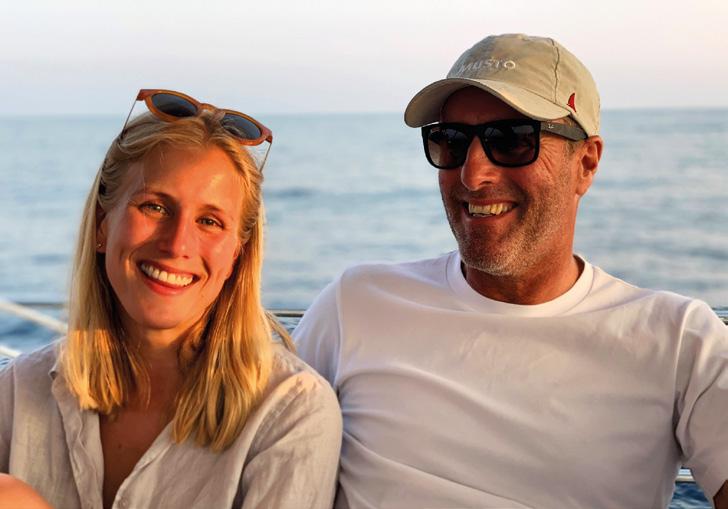
BELOW LEFT:
JORGEN AND FATHER NILS IN FRONT OF CHIONE I MOORED AT THE RCNP, PALMA.
BELOW RIGHT:
MAGNUS AT THE HELM OF CHIONE II ON THE PASSAGE TO IBIZA.
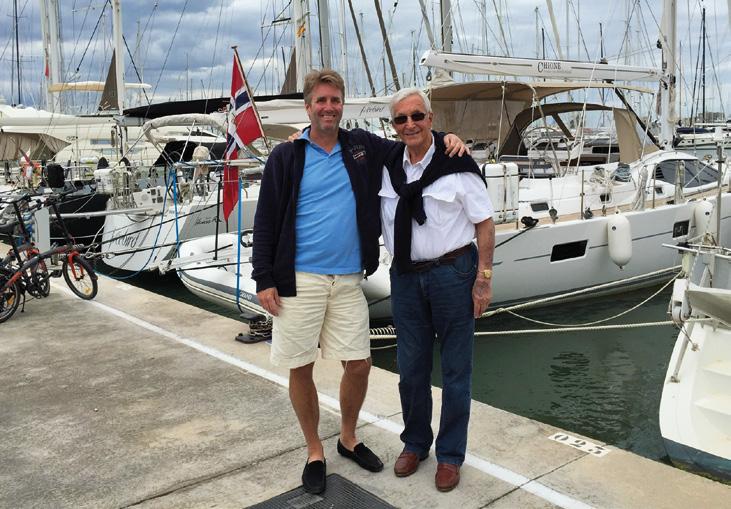



A BRIGHT FUTURE
Looking ahead to 2021, Kjaernes, like most of us, is itching to get back on the water and enjoy a more normal sailing existence. One of the biggest events Kjaernes has already signed up for is the Atlantic Rally for Cruisers (ARC) next November. “This will be a real family affair and the perfect way to deliver the yacht to the Caribbean for the winter. We are so looking forward to it.”
The Kjaernes family has another long-term cruising plan, which should happen in 2022. Kjaernes continued: “The aim is to sail the boat up the east coast of America to Newfoundland, Greenland, Iceland, then back to the Med via the UK. This will be a real test but preparations are already well underway.”
In his closing comments, Kjaernes said he would like to offer others who are thinking of commissioning a new Oyster this bit of advice: “It is very important to really listen to your project manager at Oyster and don’t have too many random ideas. I think a lot of Oyster owners who’ve had their boats for a while realise that where they took advice on yacht features/ layout, these were not only practical but also well integrated into the overall design.

“Oyster’s staff, especially the project managers, have tons of experience in practical design, so listen to them and trust them, because generally they really do know best.”
LEFT:
KINE AND JORGEN ENJOYING A WELL DESERVED G&T AFTER DROPPING ANCHOR IN RIAS BAIXAS, NORTH SPAIN,
ABOVE LEFT:
CHIONE II OFF THE COAST OF GIBRALTAR DURING HER PASSAGE TO MALLORCA.
ABOVE RIGHT:
SUNDOWNERS ON THE BATHING-PLATFORM OF CHIONE II.






